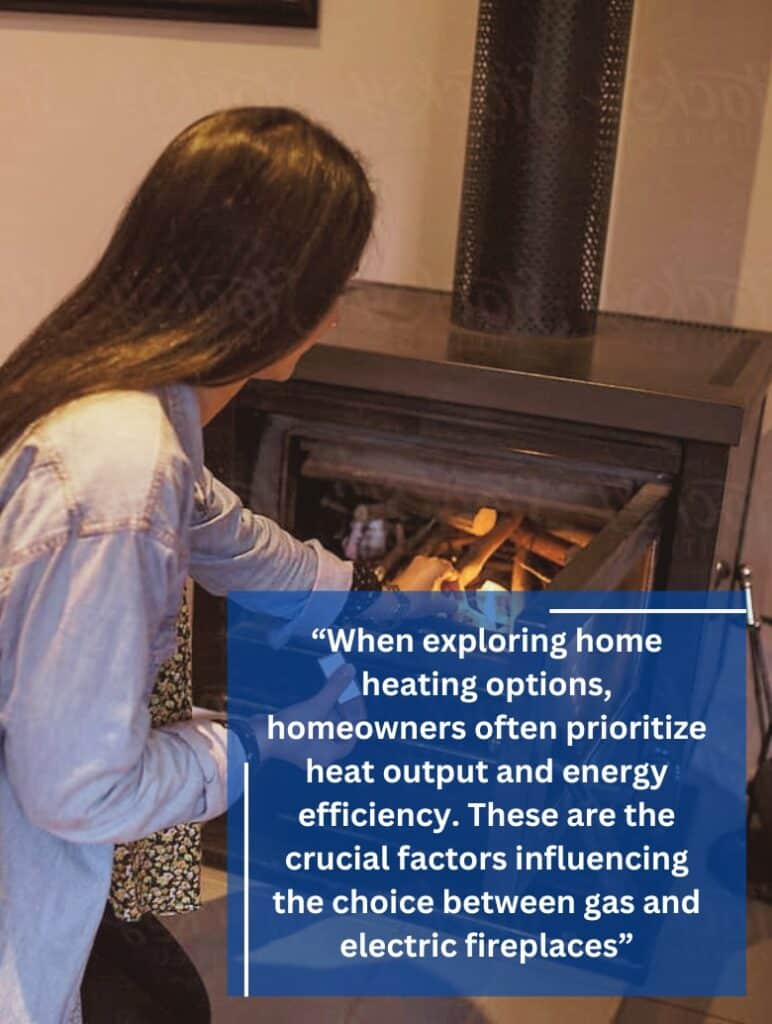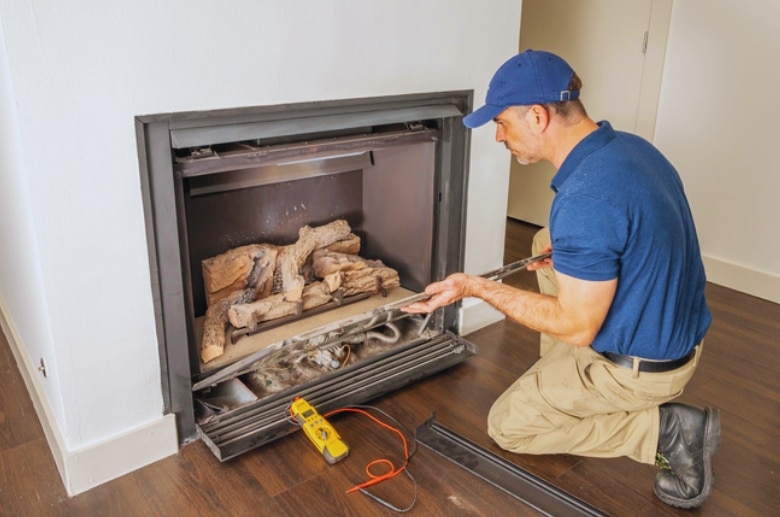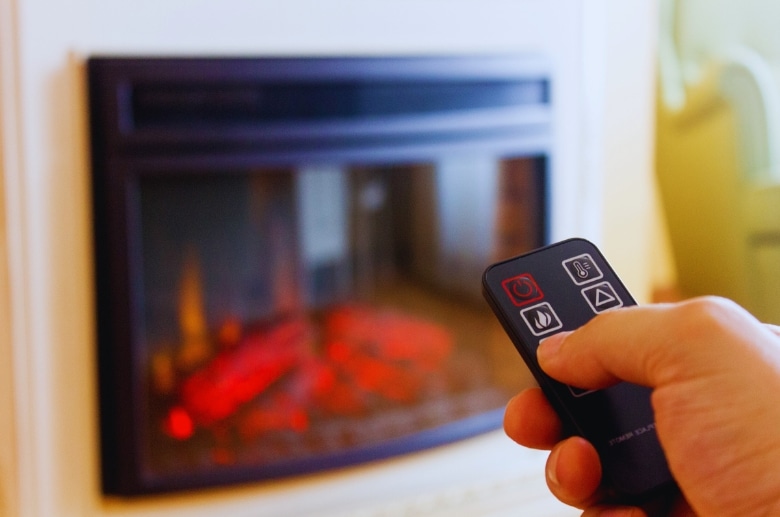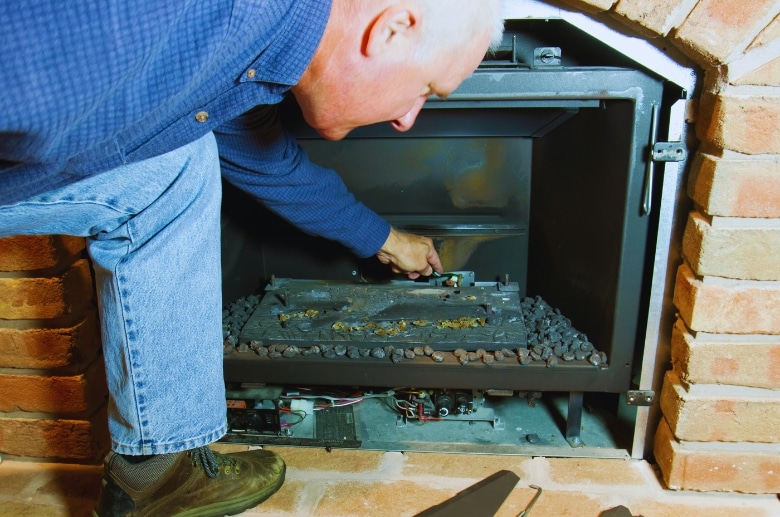A fireplace in the basement holds a unique charm, offering beauty and comfort. Yet, the choice between gas and electric fireplaces can be puzzling.
For homeowners, whether you already own a fireplace in your basement or are considering installing one, understanding the differences between basement fireplace gas vs electric is vital. We’re here to make that decision clearer for you.
Basement Fireplace Gas vs Electric Comparison
When choosing between a gas fireplace and an electric fireplace in your basement, there are several important factors to consider. Here’s a comparison of the key features to help you make an informed decision:
| Features | Gas Fireplace | Electric Fireplace |
| Heat Output & Efficacy | BTU rating varies (10,000-60,000) | Average wattage: 1500W |
| Operational Cost | Variable based on gas price, averaging 65 cents per hour | Average electricity cost: 14 to 18 cents per hour |
| Installation Cost | $2,300 to $10,000 | $200 to $4,000 |
| Safety | Potential for gas leaks, emissions | No emissions, safer |
| Environmental Impact | 60% to 80% heat efficiency rate | 99% efficiency rate |
| Aesthetic Customization | Flame appearance, log sets | Adjustable flame settings, backlighting |
| Maintenance and Cleaning | Regular checks needed | Minimal maintenance |
| Lifespan and Durability | 10 to 25 years | Around 15 years |
| Flexibility and Portability | Fixed installation | Portable and flexible |
| User-friendliness and Control | Various controls, remote, can be integrated with smart hubs | Easy controls, remote options, can be integrated with smart home automation systems |
| Resale Value | 6 to 12% boost in value | Potential value boost |
Heat Output and Efficiency

When exploring home heating options, homeowners often prioritize heat output and energy efficiency. These are the crucial factors influencing the choice between gas and electric fireplaces. Before choosing what’s best for your basement, consider these points.
Gas Fireplaces
The heat output of gas fireplaces is influenced by design and other factors like the fireplace’s model, leading to varying levels of efficiency. On average, natural gas fireplaces lose a minimum of 10% of the heat they produce.
Moreover, direct-vent gas fireplaces stand out for their efficiency, preserving approximately 70% of the heat they produce, while B-vent fireplaces achieve an efficiency range of 50% to 60%.
In contrast, gas fireplaces can produce anywhere from 10,000 to 60,000 BTUs of heat based on size. The BTUs, in conjunction with the room size, influence the fireplace’s coverage area. Additionally, the conversion rate of fuel to heat varies among gas fireplace types, often hovering between 70-80%.
——
Do You Need to Hire Chimney & Fireplace Expert?
Get free quotes from qualified experts near you. No commitment required!
——
Electric Fireplaces
Electric fireplaces are energy-efficient, typically running on 120 volts and drawing 1500 watts at 12.5 amps, generating around 7,675 BTUs of heat. More wattage means more heat but higher electricity use. They boast 100% efficiency, converting nearly all energy into heat. The 240-volt models can warm about 1,000 square feet with 8,500 BTUs.
Furthermore, electric fireplaces consume minimal electricity, generate zero emissions, and rank as the most environmentally friendly and energy-efficient option.
Operational Cost
As a homeowner or prospective buyer, understanding the operational costs of a fireplace is essential. Whether you’re considering a gas or an electric fireplace, these costs play a significant role in your decision-making.
Initial Investment and Installation Costs

When considering the addition of a gas fireplace to your home, one of the key factors to explore is the initial investment and installation costs.
Understanding the expenses of acquiring and setting up a gas fireplace is essential for planning and budgeting effectively. Here’s a breakdown of average expenses:
- Fireplace unit: Prices range from $2,300 to $10,000, varying with features and type.
- Gas line extension: Costs around $10 to $20 per linear foot, depending on distance and complexity, with an average total of $575 to $900.
- Venting setup: Direct-vent fireplaces cost $3,500 to $7,500. Ventilation upgrades range from $200 to $3,000. Adding a vent or chimney can raise costs. For a cheaper option, ventless gas fireplaces offer a cost-effective alternative to direct-vent models, which cost around $650 to $4,500, making them an attractive option for budget-conscious homeowners.
Comparatively, electric fireplace installation costs can vary based on size, style, and features. From the initial purchase price of the electric fireplace unit to the costs associated with professional installation, electrical work, mounting, and any optional enhancements, we will guide you with a basic understanding of the financial considerations entailed.
Here’s a breakdown of the average installation costs for electric fireplaces.
- Fireplace unit: Electric fireplace units range from $200 to $4,000 or more, depending on size, style, and features. Typically, they average around $800.
- Potential electrical work: Most electric fireplaces use 120 volts, drawing about 1500 watts at 12.5 amps. If your home’s wiring can’t handle the extra load, hiring an electrician to upgrade the system may be necessary. The cost will depend on installation complexity and required work, ranging from $50 to $365.
Remember that these costs are averages and can differ due to factors like location and customization. Consult a professional installer for an accurate estimate considering your situation.
Long-term Operating Costs

When evaluating the practicality and sustainability of a gas fireplace in your home, it’s essential to look into the long-term operating costs. Understanding the ongoing expenses associated with fuel, maintenance, and potential repairs is vital.
Gas Fireplaces
- Fuel price fluctuations: Due to demand, supply, and weather, natural gas and propane prices can change. Homeowners should anticipate these shifts and budget accordingly for fireplace use. On average, natural gas costs around 70 cents per MMBtu, while propane costs about $2.30 per MMBtu. This stands for one million British thermal units, serving as the standard unit for quantifying a fuel’s heating content and value. Prices may differ based on location.
- Repair and parts replacement costs: Gas fireplaces may need repairs or part replacements over time, impacting long-term operating expenses. In addition, gas fireplaces can potentially develop gas leaks, although infrequently. Costs depend on the problem and fireplace type, ranging from $150 to $1,000.
- Annual maintenance expenses: Gas fireplaces need yearly check-ups to ensure safety and proper function. These check-ups cost about $100 to $200 per inspection by professionals.
Electric Fireplaces
Comparatively, electric fireplaces are often more economical than gas fireplaces. Beyond the immediate purchase, here’s what typical operating costs look like for electric fireplaces:
- Electricity costs: The expense of electricity varies by location and local rates. On average, electric fireplaces use 1500 watts per hour, costing approximately 18 cents per hour, with the national average rate of 12 cents per kilowatt-hour.
- Operating costs: Electric fireplaces have affordable operating costs, averaging around $250 for half a year.
- Lower maintenance needs: Electric fireplaces require less maintenance than gas alternatives, lowering long-term expenses. No gas line installation, venting setup, or yearly maintenance checks are needed, saving homeowners money.
Lifespan and Durability

Gas fireplaces usually last 10 to 25 years, influenced by installation quality and maintenance. Regular care, including yearly inspections and cleaning, can prolong the fireplace’s life.
Over time, gas fireplaces may face wear and tear, affecting their performance and longevity. Common problems include pilot light, thermocouple, gas valve, fan, or blower motor issues.
In comparison, electric fireplaces typically last around 15 years, but proper care can extend their lifespan to over 20 years. The exact duration hinges on installation quality and maintenance.
Moreover, electric fireplaces generally have durable electrical parts that can endure for years with proper upkeep. However, like all electrical devices, components may wear down over time, leading to faulty wiring, blown fuses, or malfunctioning thermostats.
——
Do You Need to Hire Chimney & Fireplace Expert?
Get free quotes from qualified experts near you. No commitment required!
——
Flexibility and Portability
Regarding flexibility and portability, gas and electric fireplaces have pros and cons.
What makes a gas fireplace worth it or not? Here are some points to ponder:
Pros
- Comfortable. Gas fireplaces can instantly offer warmth to any room.
- Flexible. Some models don’t demand a gas line and electricity.
- Low maintenance. Gas fireplaces don’t produce ashes or sparks, so they are cleaned less frequently.
- Can increase home value. Since they’re permanently installed in your home, they can potentially increase your home’s value when you decide to sell.
Cons
- Permanent installation. Gas fireplaces can restrict relocation options and placement flexibility, unlike electric fireplaces.
- Health risks. Some gas fireplaces may be designed to burn fuel cleanly, but they still produce pollutants such as nitrogen dioxide and carbon monoxide.
- Bad odors. Gas fireplaces burn fuel, and the smell may become overwhelming in smaller spaces.
Electric fireplaces are often compared to their gas counterparts. Before buying one, here are some pros and cons you need to consider:
Pros
- Great portability. You can effortlessly shift them from room to room.
- Ventless. No need for external venting or intricate setup.
- Safety concerns. Electric fireplaces don’t emit any emissions or require fuel; ventilation and safety concerns during relocation are non-existent.
- Not permanent. You can switch its location easily, like when moving to a new home.
- Aesthetic. Because of its artificial flames, it can look nicer than its gas counterpart.
Cons
- Careful placement. If placed next to flammable materials such as curtains or cloth, the material may heat up and ignite flames.
- No real flames. Some people don’t like artificial flames.
- Higher electrical costs. Depending on where you live, electricity may have higher costs than gas.
User-friendliness and Convenience
When it comes to heating your home with both comfort and convenience, the choice often comes down to the timeless appeal of a gas fireplace or the contemporary convenience of an electric one.
Gas fireplaces offer versatile flame control, from manual options to handy remote control or smartphone apps. Some models even allow flame height adjustments for that perfect, personalized ambiance. Plus, they feature hassle-free electronic ignition for quick starts.
On the other hand, for electric fireplaces, convenience reigns supreme. Imagine the luxury of warming up your space with just a touch of a button. Many models even come with remotes, allowing you to change your fire’s ambiance effortlessly.
But that’s not all – some electric fireplaces have embraced the future with smart home integration like Alexa: voice commands and seamless interaction with your smart home hub.
Aesthetic and Space Considerations

When it comes to choosing the heart of your home’s ambiance, aesthetics and space considerations are key as these significantly influence the overall atmosphere and appeal of your living space. Gas and electric fireplaces offer distinct styles and spatial advantages, each with its unique allure.
Gas Fireplaces
Gas fireplaces bring both style and personalization into your home. Homeowners can tailor the flame appearance, colors, and design elements like log sets and stones to create a unique, lifelike fire that suits your taste.
As far as space considerations, consider venting requirements and their impact on installation when choosing your fireplace. Direct-vent models offer flexibility, while vent-free options require proper ventilation.
Additionally, if you choose propane, consider the space needed for a gas tank, while natural gas eliminates this requirement, offering a space-efficient and convenient heating solution.
Electric Fireplaces
Alternatively, electric fireplaces truly excel when it comes to making your home uniquely beautiful and practical. You have the freedom to create your perfect ambiance with adjustable flames, glowing embers, and customizable backlighting. What’s even better is that these fireplaces don’t need vents, so you can place them just where you want for maximum flexibility.
Environmental Impact and Sustainability
In the battle for the eco-friendly crown, gas and electric fireplaces go head to head.
Gas Fireplaces
Gas fireplaces emit harmful gases like carbon monoxide, nitrogen oxides, and volatile organic compounds (VOCs), impacting air quality and health.
Natural gas, despite its clean-burning properties, poses environmental hazards. Extracted via fracking methods, it has substantial indirect environmental consequences. Being non-renewable and methane-rich, it contributes to toxic greenhouse gas emissions. Additionally, natural gas presents health risks, necessitating carbon monoxide alarms in gas-powered homes.
——
Do You Need to Hire Chimney & Fireplace Expert?
Get free quotes from qualified experts near you. No commitment required!
——
Electric Fireplaces
In comparison, electric fireplaces offer substantial energy savings, typically reducing heating costs by 20 to 40%. They efficiently warm your primary living spaces and are straightforward to install, enhancing aesthetics. These versatile units can be easily added to any room, providing instant warmth and ambiance.
They emit no harmful gases or particles, enhancing indoor air quality and avoiding venting risks. Electric fireplaces are 99% efficient, converting most energy into heat, surpassing gas counterparts that lose heat through chimneys.
Resale Value and Home Appeal
When it comes to enhancing your home’s appeal and resale value, fireplaces are one of the most sought-after additions. Gas and electric fireplaces each bring their unique charm to the table.
According to the Office of Energy Efficiency, a gas fireplace can boost a home’s resale value by 6% to 12%. Homes with gas fireplaces are highly sought after by buyers, making them a wise investment. The coziness and allure of gas fireplaces appeal to those seeking an inviting atmosphere, elevating a home’s charm and value.
On the other hand, electric fireplaces impact resale value by 5%. Their modern look appeals to tech-savvy buyers, with features like remote controls attracting those seeking advanced heating solutions. The advantage of being removable and replaceable could entice some homeowners. Yet, this adaptability might add less value than a permanent gas fireplace.
Safety Considerations
Gas fireplaces demand vigilant safety considerations to mitigate potential hazards. Here are the key aspects to consider:
- Proper installation – Gas fireplaces can release gases like carbon monoxide, nitrogen oxides, and volatile organic compounds (VOCs). Inadequate installation or maintenance practices can result in gas leaks, which pose serious dangers and the potential for house fires.
- Appropriate venting – Direct vent gas fireplaces are generally considered the safest choice, as they draw fresh air from outdoors and expel combustion gases outside.
- Regular inspections and maintenance – Qualified technicians should conduct annual inspections to assess gas leaks, verify proper venting, and address any safety-related concerns.
In comparison, electric fireplaces are generally regarded as safer alternatives to gas or wood-burning fireplaces. Here are the key aspects to remember:
- Safer indoor air quality – Electric fireplaces eliminate the risk of carbon monoxide exposure or other harmful emissions. Many electric fireplaces include an automatic shut-off feature, providing an additional layer of safety.
- No leaks – Electric fireplaces are safer than wood-burning fireplaces, which carry the potential for fire hazards and harmful emissions. They also surpass gas fireplaces in safety, as gas varieties can emit gases like carbon monoxide and necessitate proper venting to prevent gas leaks.
- Convenient and easy installation – Their installation is hassle-free, as they require no fuel, venting, or professional setup. Furthermore, they excel in energy efficiency by converting nearly all the consumed energy into heat.
Maintenance and Cleaning
Maintaining your fireplace isn’t just about keeping the flames alive; it’s about ensuring your cozy haven stays safe and efficient.
Gas Fireplaces
Gas fireplaces require regular inspections and maintenance once a year to ensure safe and efficient operation. Gas lines, burners, and venting systems should be checked periodically. Moreover, you should check regularly for gas leaks, which may start a house fire.
Electric Fireplaces
Electric fireplaces on the other hand require minimal maintenance, mainly focused on keeping the unit clean by dusting and cleaning the unit’s exterior. Another thing that you can do is check proper electrical connections, ensuring that the outlet and cord are in good condition.
Overall Winner
In comparing basement gas fireplaces and electric fireplaces, the electric fireplace emerges as the overall winner. With its lower environmental impact, safety features, ease of installation, and user-friendly controls, the electric fireplace proves to be a convenient and attractive choice.
While gas fireplaces offer higher heat output and potential resale value boost, the benefits of the electric fireplace, including its energy efficiency and flexibility, make it a smart and practical option for creating a cozy and inviting basement space.






